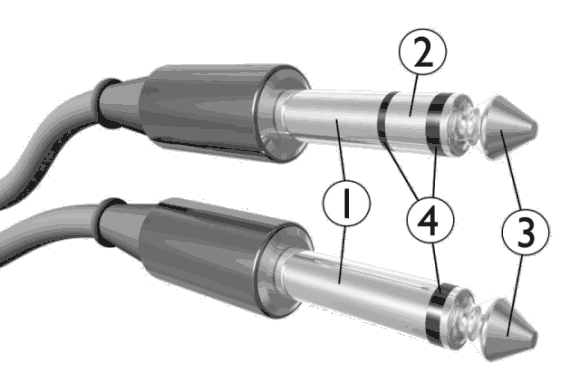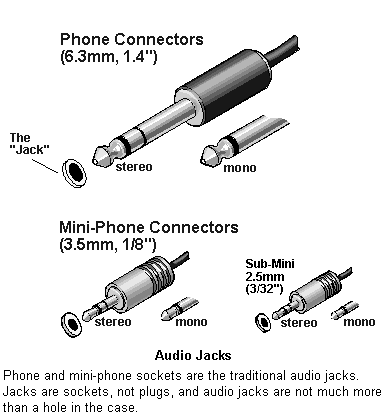TRS Phono Plug: Difference between revisions
mNo edit summary |
|||
| (7 intermediate revisions by 2 users not shown) | |||
| Line 1: | Line 1: | ||
This audio jack is commonly seen on stereo headphones for audio devices such as a Sony Walkman, and some cell phones, although there is a wide range of uses including audio input as well as output. The TRS phono plug connector is an audio jack with 3 contact places on the jack separated by two insulation layers. TRS is an acronym representing '''T'''ip + '''R'''ing + '''S'''leeve. The 2 contact (Tip + Sleeve or TS) version is typically for mono audio and the three contact version (TRS) is typically for stereo audio. There are also other variants such as a four contact version which is often designed for camcorders, the extra ring for the video signal, or for modern cell phones and mobile devices facilitating earphone and microphone combination headsets. Again, these are common uses, with audio being the most widely implemented application. | |||
A TS plug or Tip Sleeve plug has two contacts, which are sometimes referred to as poles. So a TS is a one ring two pole connector. TS = 1 Ring and 2 Pole | |||
A TRS plug or Tip Ring Sleeve plug has three poles. So a TRS is a two ring three pole connector. TRS = 2 Ring and 3 Pole | |||
== Divisions == | == Divisions == | ||
| Line 6: | Line 10: | ||
== Polarity == | == Polarity == | ||
There is a standard accepted in the industry for audio devices. | |||
[[Image:wiki-stereo-phono-jack.gif]] | [[Image:wiki-stereo-phono-jack.gif]] | ||
| Line 31: | Line 37: | ||
* Ring - Right channel | * Ring - Right channel | ||
* Sleeve - Common (ground) | * Sleeve - Common (ground) | ||
[[Image:tipringsleeveaudioleftright.jpg]] | |||
=== PC99 computer Audio connections (3.5mm 3 pole jack) === | === PC99 computer Audio connections (3.5mm 3 pole jack) === | ||
| Line 91: | Line 99: | ||
:1. Quarter Phono (1/4) - common for band equipment, mixers, DJ equipment, and legacy headphone (studio). | :1. Quarter Phono (1/4) - common for band equipment, mixers, DJ equipment, and legacy headphone (studio). | ||
:2. Mini Phono (1/8) - common for Walkman, portable audio, iPod, modern headphones and some newer mobile phones. | :2. Mini Phono (1/8) - common for Walkman, portable audio, iPod, modern headphones and some newer mobile phones. | ||
:3. Sub-Mini Thirty-Second (3/32) - standard for mobile phone audio connector, however, | :3. Sub-Mini Thirty-Second (3/32) - standard for mobile phone audio connector, however, 1/8 is become more common on newer models. | ||
| | ||
Latest revision as of 13:28, 16 October 2023
This audio jack is commonly seen on stereo headphones for audio devices such as a Sony Walkman, and some cell phones, although there is a wide range of uses including audio input as well as output. The TRS phono plug connector is an audio jack with 3 contact places on the jack separated by two insulation layers. TRS is an acronym representing Tip + Ring + Sleeve. The 2 contact (Tip + Sleeve or TS) version is typically for mono audio and the three contact version (TRS) is typically for stereo audio. There are also other variants such as a four contact version which is often designed for camcorders, the extra ring for the video signal, or for modern cell phones and mobile devices facilitating earphone and microphone combination headsets. Again, these are common uses, with audio being the most widely implemented application.
A TS plug or Tip Sleeve plug has two contacts, which are sometimes referred to as poles. So a TS is a one ring two pole connector. TS = 1 Ring and 2 Pole
A TRS plug or Tip Ring Sleeve plug has three poles. So a TRS is a two ring three pole connector. TRS = 2 Ring and 3 Pole
Divisions
The divisions of the plug in phone, mini-phone and sub-mini connectors that represent the different conductors. Tip (T) and ring (R), along with the sleeve (S), are used in two-conductor (TS), three-conductor (TRS) and four-conductor (TRRS Phono Plug) variations.
Polarity
There is a standard accepted in the industry for audio devices.
- 1. Sleeve: usually ground
- 2. Ring: Right-hand channel for stereo signals, negative phase for balanced mono signals, power supply for power-requiring mono signal sources
- 3. Tip: Left-hand channel for stereo signals, positive phase for balanced mono signals, signal line for unbalanced mono signals
- 4. Insulating rings
Tip
The tip is normally left - as left is conventionally follows mono as regards wiring convention.
Mono Jack wiring
Common on musical instruments, stomp boxes and unbalanced microphones
- Tip - signal (Hot)
- Ring - Ground
Stereo Jack Connections
The contacts of a stereo plug are allocated as follows
- Tip - Left channel
- Ring - Right channel
- Sleeve - Common (ground)
PC99 computer Audio connections (3.5mm 3 pole jack)
As used on PC sound card microphone inputs (outputs and line inputs follow the regular stereo jack connections above). 3.5mm connectors are used.
- Tip - Mic input
- Ring - +5V supply, (via a limiting resistor usually)
- Sleeve - Ground
Theory on Stereo to Mono Conversion
Speaking strictly on what is called unbalanced stereo audio converted to unbalanced mono audio, should one combine the ring + tip or short the ring to the sleeve on a TRS phono plug?
According to one source, shorting leads to create a mono signal has been used for the past 50 or so years with headsets. The stereo plug has a tip, ring and sleeve section while a mono headset will have only a tip and sleeve. When the mono headset is plugged into a stereo jack, both ring and sleeve contacts the sleeve section of the mono plug thus combining the two channels into a mono signal.
According to another source, the flaw of the TRS TS design is that when a mono TS plug is inserted into a stereo TRS jack, it shorts out the right channel to ground, simulating a 0-ohm load. This could be harmful to some equipment (burn out your iPod).
Headsets with a mono/stereo switch also combine the channels by shorting the two hot leads.
The signal is invariably on the tip of the plug, and the metallic sleeve closest to the body of the plug is the shield/ground.
However, the RadioShack 274-378 1/8" Stereo Male to RCA Female adapter combines (2) ring and (3) tip to go from a stereo phone to a mono RCA connector. This contracts to inserting a mono plug into a stereo jack, where as the (1) ground sleve would be combined with the (2) ring via the absent of the ring on the mono TS (Tip + Sleeve) plug. So where should the (2) ring audio channel really go? With the sleeve ground or the left phase tip?
There are different types of stereo-mono adapters. Depending on their genders and how they interface between the two-conductor tip-sleeve plug on the mono end and the three-conductor tip-ring-sleeve plug on the stereo end, the adapter may just be shorting right to ground and passing a left signal (as would happen if you plugged a mono headphone plug into a stereo jack).
Conclusion:
Inserting a mono TS plug into a stereo TRS jack will short the right audio to the sleeve ground, resulting in mono playback with only the left channel present. Audio from the right channel will be lost. This practice may also present a risk to the line level source.
Using a conventional off the shelf stereo to mono adapter combining the ring and tip (right and left) audio from a stereo source into a TS plug typically preserves audio from both tracks, however, sound quality may be lost due to the way the audio is phased. Some sensitive audio line level sources may also be at risk when combining left and right audio.
The most ideal solution is to use a powered device to combine the two stereo channels into a single mono channel, such as a mixer.
Balanced Mono and Unbalanced Stereo
When a TRS is used as a single channel connector in a balanced system, it is called a balanced TRS connector. The balanced TRS connector is commonly of the quarter inch type and carries a line level signal. In professional audio the TRS connector is used for a mono signal to carry balanced audio as opposed to the consumer home electronic world where the same (very simular) connector is used for what is called an unbalanced stereo signal.
With balanced audio two identical signals are inverted 180° out of phase. If combined by shorting the T + R they will cancel each other out. Balanced cables in such systems are designed to carry two versions of any given signal and are manipulated in polarity relative to each other to eliminate noise and hum.
Balanced audio cables use three lines. They consist of a hot line (positive), cold line (negative) and the ground. The audio signal is transmitted on both the hot and cold lines, but the voltage in the cold line is inverted in polarity so it is negative when the hot signal is positive. These two signals are often referred to as being out of phase, which is incorrect. They are not out of phase via a delay, but rather in phase and mirror images of one another in terms of polarity. They are equal and opposite.
If an inexpensive stereo to mono adapter is used on a balanced TRC connector, the combination of T + R will create a line out of the two waves, one being inverted, resulting in a dead signal (no sound.)
Balanced Audio Tip-Ring-Sleeve (TRS) Jack Plug Connections
Often implemented with the professional TRS jack
- Tip - Hot (+)
- Ring - Cold (-)
- Sleeve - Ground
note: The professional TRS jack can be told apart by the fact that the tip and ring metal parts have a smaller diameter than the sleeve, and TRS plugs often have brass contact surfaces. Stereo jacks are usually nickel-plated, so there is a color difference too. Forcing the domestic stereo jack plug into a professional TRS socket will often bend the contacts of the socket so it does not make good contact in future when mated with a TRS plug.
Sizes
- 1. Quarter Phono (1/4) - common for band equipment, mixers, DJ equipment, and legacy headphone (studio).
- 2. Mini Phono (1/8) - common for Walkman, portable audio, iPod, modern headphones and some newer mobile phones.
- 3. Sub-Mini Thirty-Second (3/32) - standard for mobile phone audio connector, however, 1/8 is become more common on newer models.


